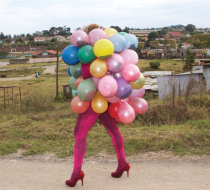Performance Obscura Favorite
In her curatorial project Making Way, Ruth Simbao brought together works that complicated the idea of globalization’s effect on African nations, especially the idea that the new phase would usher in an almost frictionless movement of labor and capital across borders. Works by artists like Athi-Patra Ruga reflected on questions of how bodies moved through settler colonialist spaces. Ruga’s performance Obscura, Grahamstown (2014), in which official art viewers missed the most spectacular part of the performance, involved the artist walking through the countryside covered with balloons.
“A small, paying audience climbed up the spiral staircase of the Observatory Museum during the festival expecting to receive, in exchange for a limited number of highly sought-after tickets, a privileged bird’s-eye view (through the 19th century camera obscura) of Ruga on the streets below. In Performance Obscura, Ruga was dressed up as the recurring character the Future White Woman of Azania (FWWOA) who was also present at the 2013 Venice Biennale, and recently performed in San Francisco for the exhibition Public Intimacy (2014). In name, this character alludes to the extolled but never fully realised home of the black consciousness movement. Although Subotzky was planning to photograph Ruga’s mediated image as it appeared on the camera obsucra screen or plate, he was unfortunately not able to be present, and his assistant was asked to take photographs for him. However, in the context of last minute changes, the operator of the camera obscura was unable to locate the Future White Woman of Azania on the streets, and so instead led the paying audience through the standard tour of Grahamstown via his optical device.
Meanwhile, defiantly parading the downtown streets of Grahamstown in her weighty attire of paint-filled balloons, the Future White Woman of Azania returned what she assumed to be the expectant gaze of the privileged audience by staring back at the tower through a pair of binoculars. However, she was unaware of the fact that the so-called advantaged, art-savvy group was already rendered blind by the slippage of the camera obscura operator’s hand.
In this site-specific, or rather site-situational work, Athi-Patra Ruga powerfully overturned the potentially furtive gaze of the camera obscura, which in the 19th century functioned as a ‘big-brother’ tool and was used, for example, to locate the local doctor walking down the street. While the word ‘furtive’ suggests a stolen, hidden or secret gaze, the White Woman of Azania pushed back at the potential gaze from the cloistered audience in the tower. Rather than being potentially ‘dissected under white eyes’ or ‘fixed’, as Frantz Fanon (1967:116) writes in Black Skin, White Masks, the unexpected situation allowed Ruga to rob the paying audience of a glimpse of this character’s spectacle. Instead, he performed lavishly for casual bystanders on the street who were given the privileged opportunity to capture his image on their cellphones; hear the squeak of paint-laden balloons rub against each other; feel the spurt of colorful liquid as Ruga violently popped balloons against a Boer War statue, and engage face-to-face with the intense emotion of this figure occupying their streets.








